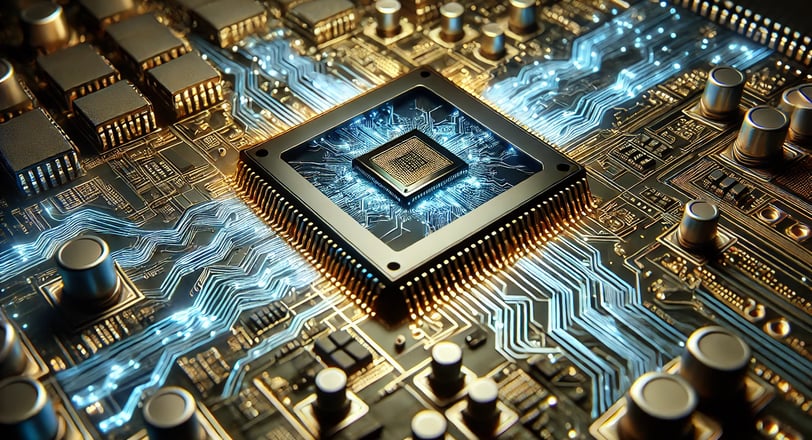The Invention of the Microchip: The Revolution of Modern Technology
The microchip, also known as an integrated circuit, is one of the greatest inventions in the history of technology. It revolutionized electronics, making possible the development of computers, smartphones, electronic devices, and a multitude of modern applications. But how did this invention come about? What challenges were faced? How did it evolve into today’s modern chips? In this article, we explore the entire journey of the microchip, from its origins to the latest advancements.
3/16/20252 min read


The Early Days of Electronics and the Path to the Microchip
Before the emergence of the microchip, electronic devices relied on vacuum tubes, which were large, inefficient, and consumed a lot of energy. In the 1940s, the need for miniaturization led scientists to seek more efficient alternatives.
The first major breakthrough was the invention of the transistor in 1947 by scientists John Bardeen, Walter Brattain, and William Shockley at Bell Labs. The transistor replaced vacuum tubes, making circuits more compact and reliable. However, circuits still had to be manually assembled, limiting scalability.
The Invention of the Integrated Circuit
In the 1950s, two scientists, Jack Kilby of Texas Instruments and Robert Noyce of Fairchild Semiconductor, independently worked on integrating all circuit components into a single piece of semiconductor material. In 1958, Kilby built the first functional integrated circuit, marking the birth of the microchip. The following year, Noyce refined the design by developing a more efficient manufacturing process using photolithography.
This invention revolutionized the industry by enabling the miniaturization of electronic components and allowing mass production of integrated circuits.
Challenges and Early Advances
The first integrated circuits had limited capacity and performance, but they quickly advanced with improvements in semiconductor materials and manufacturing processes. In the 1960s and 1970s, companies like Intel, IBM, and Fairchild Semiconductor began producing more advanced chips, leading to the emergence of the first microprocessors.
In 1971, Intel introduced the Intel 4004, the world’s first microprocessor, created by Federico Faggin, Ted Hoff, and Stanley Mazor. It contained 2,300 transistors and operated at 740 kHz. This was the starting point for the personal computer revolution.
The Evolution of Microchips
The evolution of microchips followed Moore’s Law, proposed by Gordon Moore, co-founder of Intel, in 1965. The law predicted that the number of transistors in a chip would double approximately every two years, increasing processing power and reducing costs.
Over the following decades, microchips evolved dramatically:
1980s: Microprocessors like the Intel 8086 and Motorola 68000 powered the growth of personal computers.
1990s: More powerful chips enabled advances in computer graphics and parallel processing.
2000s: The emergence of multi-core chips allowed for greater efficiency and performance.
2010s and 2020s: AI chips from NVIDIA and Google revolutionized artificial intelligence, while ARM-based processors became essential for mobile devices and servers.
Companies and Equipment Using Microchips
Today, microchips are found in virtually every electronic device. Some of the largest chip manufacturers include:
Intel: A leader in processors for computers and servers.
AMD: Intel’s competitor, known for high-performance CPUs and GPUs.
NVIDIA: Specializes in chips for graphics and AI.
Qualcomm: A key player in mobile device chips.
TSMC and Samsung: The world’s leading semiconductor manufacturers.
Microchips are used in:
Computers and smartphones
Autonomous vehicles and in-car entertainment systems
Medical equipment, such as pacemakers and MRI scanners
Satellites and spacecraft
Internet of Things (IoT) devices, connecting smart technologies
The Future of Microchips
With miniaturization reaching physical limits, new technologies are being explored to continue chip evolution:
2nm Chips: Companies like IBM and TSMC are developing smaller and more efficient chips.
Quantum Computing: Could revolutionize processing power, solving problems impossible for classical computers.
Neuromorphic Computing: Chips inspired by the human brain’s functionality, improving AI efficiency.
Photonic Chips: Use light instead of electrons, enabling incredible processing speeds.
Conclusion
The invention of the microchip irreversibly transformed the world. From the first integrated circuits to modern processors, its evolution has driven advances in computing, communications, and artificial intelligence. The future promises even more astonishing developments, fostering innovations across all sectors of society. The microchip remains the backbone of the technological revolution, and its impact will only continue to grow in the years to come.
Explore
Discover diverse topics in one convenient hub.
Connect
Learn
contact@mindstormblog.com
© 2025. All rights reserved.


